California Morels: A Delicious Enigma!
© Debbie Viess, May 12, 2015
Morels are some of the most challenging of all mushrooms to hunt. If you do your homework, and study their fruiting patterns, and go to suitable habitat, and get your morel eyes on, and search and search and search and then actually find these cryptic delicacies, can you then rest on your laurels and just have a nice meal? Not if you are a true mushroom geek and also want to discover their unique latin name! If you do find a distinctive morel, and you manage to reasonably match it up to a latin species, then there is the dilemma of which latin name to use, among several possible synonyms. And you thought the finding was hard!
Nomenclatural battles over latin morel names have recently been waged across North America and Europe, with practically simultaneous 2012 publications of new morel names by both Michael Kuo et al here in NA, and a major paper on worldwide morel distribution by Philippe Clowez of France. Confusion reigned over name precedence and just which morels were synonymous. A bit more clarity was reached in late 2014, with the publication of "True morels (Morchella, Pezizales) of Europe and North America: Evolutionary relationships inferred from multilocus data and a unified taxonomy," Franck Richard et al.
Here is what we currently know about California morels, as of May 2015...
 Morchella rufobrunnea in wood chips |
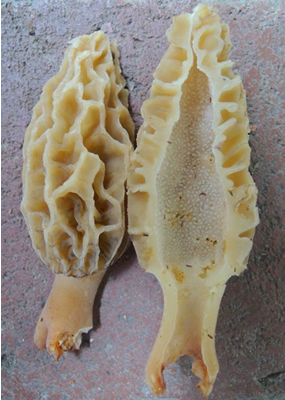
Morchella rufobrunnea blonde from garden mulch |
The earliest fruiting California morels are the pale, reddening, conical-capped Morchella rufobrunnea. When immature this morel has pale ridges and black vertical pits; in age the cap becomes a dull yellow. Often referred to as the "Wood Chip Morel," rufobrunnea is found in various "human-scapes": from olive orchards in the Central Valley, to urban beauty bark beds, to flower pots, anywhere! It is the only morel that commonly fruits in the fall, but has been found from January to December across California. Sadly, despite its uncommon availability to urban foragers, it is the least tasty California morel species. Rufobrunnea behaves as a saprobic mushroom, may not have any tree associations, and is the only morel that has been successfully cultivated here in the US, success being a relative term. Rufobrunnea is genetically basal to all other morel species worldwide. It is not a blonde morel (Esculenta clade) or a black morel (Elata clade), but in its very own Rufobrunnea clade, along with one other morel species recently described from Turkey, M. anatolica.
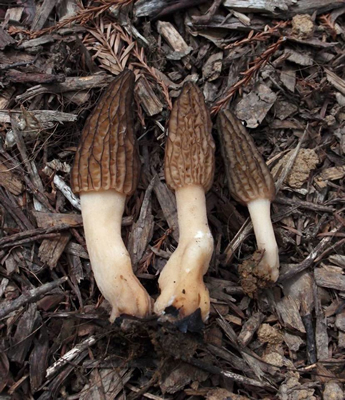
Morchella importuna in wood chips, photo by Doug Smith
A second species of a black western woodchip morel is far less common here in CA: Morchella importuna or the "Laddered Morel." These thin-fleshed, elongated morels often have parallel vertical pits and cross-bars that give the cap a laddered effect.
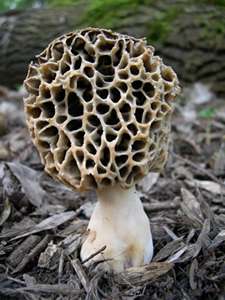
Morchella americana, Bidwell Park, Chico |
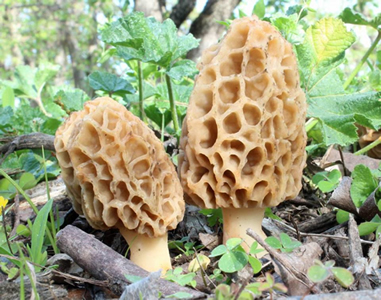
Morchella americana, Central Valley Pear Orchard |
Next to arrive on the morel scene are "natural" morels, or those not associated with fire. In fruit orchards and along sandy riverbanks we can find Morchella americana, the only true California blonde morel. Morchella americana, the "Blonde Morel" or the "Common Morel" has a worldwide distribution. It differs from rufobrunnea, which it sometimes resembles, in having a rounded cap apex and sometimes rounded rather than elongated pits. A second species of western blonde morel, Morchella prava, with a continent-wide distribution, has not yet been confirmed from California, but may occur here. It resembles a distorted version of M. americana but is DNA distinctive.
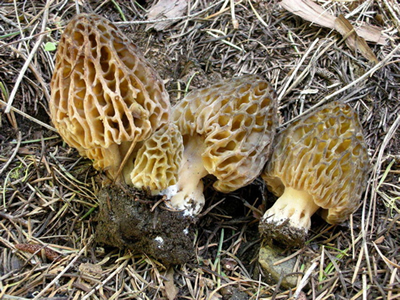
Morchella snyderi, yellow form, Yosemite National Park |
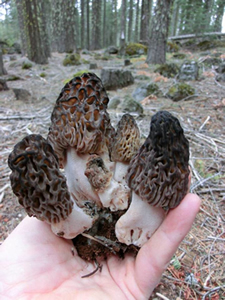 Morchella snyderi, Sierra, photo by Debbie Viess |
As morel season progresses, we start to see natural black mountain morels like Morchella snyderi. M. snyderi is morphologically distinctive, with a sinus between the cap and stem attachment ("ant racetrack" is the clever description coined by Kuo), and a prominently creased and buttressed stipe. When young, its pale yellow ridges can cause it to resemble a blonde morel; with age the cap darkens. M. snyderi is widespread and common. They fruit in undisturbed conifer forest, lightly disturbed forest like in campgrounds and along roads, and in areas with heavy machinery disturbance and woody debris. They are not found in burns the first spring following, but may appear several years after a burn.

Morchella tridentina, Yosemite Valley, photo by Noah Siegel
Another blonde morel mimic is the natural "Mountain Blonde" or "Western Blonde," Morchella tridentina, which has a blonde color but the morphology (and DNA) of a black morel, with vertical pits and a sinus between cap and stipe. No wonder Kuo called this one "Morchella frustrata"! Like rufobrunnea, it commonly reddens.
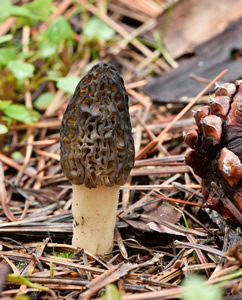
Morchella brunnea, Stanislaus National Forest, |

Morchella brunnea, Stanislaus National Forest, |
Morchella brunnea, a member of the elata clade, has only recently been confirmed here in California; it is a western species that also occurs in the PNW. It appears early in the mountain morel season, and is found in unburned conifer forest. The edges of its pits are dark throughout its development, and the stem is equal in width or only slightly swollen at its base.

Morchella populiphila, Sierra, photo by Thea Chesney
Returning to the Morchella fold is the local "Half-free Morel," formerly Mitrophora/Morchella semilibera, now Morchella populiphila. It is an early morel with a sometimes elongated stipe and a cap that is only partially attached to the stipe or "half-free." It can be found in sandy soil near river bottoms and is often associated with black cottonwood.
Finally, we get to the most famous and sometimes ridiculously abundant of our California black morel species, the burn morels. Burned forest is a familiar natural phenomenon in the western mountains, and several species of morels are adapted to fruit in the spring or summer following a burn.
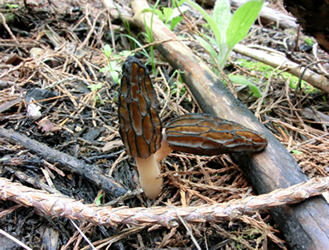
Morchella eximia, Sequoia NF creekside, photo by Debbie Viess |
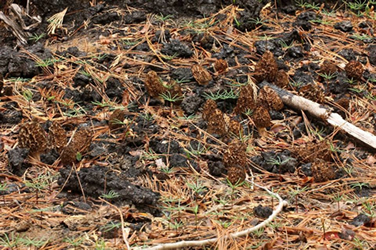
Morchella sextelata, Yosemite Rim Fire, photo by Alan Rockefeller |
Three similar species of black western "Burn Morels" are found at lower mountain elevations, primarily in burned conifer forests: Morchella eximia, Morchella sextelata and Morchella exuberans. Eximia and sextelelata are morphologically identical, but DNA distinctive. Morchella eximia is the only one of the three that is often (but not always) found associated with seeps or creeks, so that habitat feature, when available, can be used to separate it out from its morphological lookalikes.
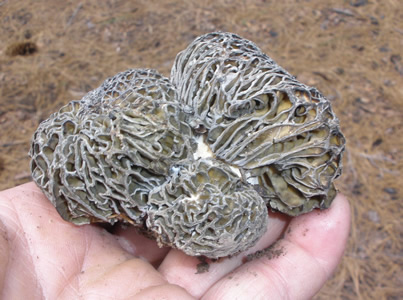
Morchella exuberans, Sierra, photo by Hugh Smith
Morchella exuberans often shows an internally folded and chambered stipe; both eximia and sextelata have simple, hollow stipes. Morchella exuberans can also be distinguished from eximia and sextelata through microscopy: exuberans has abundant capitate terminal cells on the cap ridges.

Morchella tomentosa, photo by Debbie Viess
And finally, another morphologically distinctive black burn morel, Morchella tomentosa, the "Western Gray Morel" or "Fuzzy Foot," is found later in the mountain season and at higher elevations, again in burned conifer forest. This morel is both tomentose (fuzzy) and dark, on both cap and stipe, although these distinctive colors can fade with strong sun exposure. Tomentosa also often has a double walled stipe.
So there you have it, the current California latin morel names in a nutshell! Sometimes, attempting to put names on your morel finds will drive you nuts, too. So don’t sweat the small stuff. All morels are edible and good, and they don’t care what you call ’em.
If you do want to take a stab at categorizing your morel finds this article should help you on your way. But first you have to find them, and that’s not easy. Morels in California mimic many other objects in their environment, from pinecones, to bundles of pine needles, to burned bits of wood; even their strongly patterned caps help them to disappear in a visually busy forest floor. Finding and seeing morels is just the first difficult step in their acquisition; putting an "accepted" latin name on them is the next. Not to worry: although not every morel is easily identifiable to species, they are all edible and a delicious reward for your hard work.
Morphologically Distinct Morels in California
Wood-Chip Habitat
- M. rufobrunnea: pale ridges, black pits when young, blonde in age, pointed cap, reddens
- M. importuna: black morel with an elongated form, laddered pits
Naturals
- M. brunnea: mountain black morel with uniform stipe or only sl. expanded base, pit edges start and stay dark
- M. tridentina: mountain black morel with a blonde color, with a sinus between the cap and stipe, vertical pits, often reddens
- M. snyderi: mountain black morel with buttressed stipe, sinus between cap and stipe; ridges start out yellow but darken with age
- M. populiphila: black morel with cap partially attached to the stipe (half-free)
Burns
- Morchella tomentosa: black morel with dark fuzzy cap and stipe, often double walled
Pseudo-Blonde Morels
Resemble Blondes at some point in growth
- M. rufobrunnea (Rufobrunnea clade): dull yellow in age
- M. tridentina (Elata clade): yellow color, black morel form
- M. snyderi (Elata clade): start out yellowish, darkens with age
Greens and Pinks and Grays, Oh My!
Mushrooms are variable in form and coloration. Morels are no exception. Color alone is insufficient to make an ID, and the various odd morel colors seen in nature (like green and pink morels) are not correlated with any single species. Morels also change color with age. Here in the west only, Gray morels refer to M. tomentosa. No one said this was gonna be easy!
Genetically Distinctive but Still Undescribed California Morels
- mel-8: morphologically similar to M. brunnea; "mel" is shorthand for Morchella elata.
Western Morels not (Yet?) Documented for California
- Morchella prava: blonde natural morel that resembles a contorted M. americana
Recent Synonyms for Current California Morel Names
- M. americana = (californica, esculentoides)
- M. eximia = (anthracophila, carbonaria, septimelata)
- M. exuberans = (capitata)
- M. tridentina = (frustrata)
References
- Beug, Michael, Alan E. Bessette, Arleen R. Bessette. 2014. Ascomycete Fungi of North America: A reference guide. Texas University Press, pp. 179-194
- Clowez, Phillippe. 2010. Les morilles, une nouvelle approche mondiale du genre Morchella. Bulletin de la Société Mycologique de France 126(3-4):199-376
- Gibson, Ian. 2015. Morchellacea in the PNW, an Introduction. Pacific Northwest Key Council. http://www.svims.ca/council/Morche.htm
- Kuo, Michael. 2008. Morchella tomentosa, a new species from western North America, and notes on M. rufobrunnea. Mycotaxon 105: 441- 446
- Kuo, Michael, Damon R. Dewsbury, Kerry O'Donnell, M. Carol Carter, Stephen A. Rehner, John David Moore, Jean-Marc Moncalvo, Stephen A. Canfield, Stephen L. Stephenson, Androw S. Methven, Thomas J. Volk. 2012. Taxonomic revision of true morels (Morchella) in Canada and the United States. Mycologia, 2012 vol. 104(5) pp. 1159-1177
- Kuo, M. (2012, November). The Morchellaceae: True morels and verpas. Retrieved from MushroomExpert.com: http://www.mushroomexpert.com/morchellaceae.html
- Mushroomobserver.org. Resource for morel photos, plus collection dates and locations of all currently known and described California morel species. http://mushroomobserver.org/
- Richard, Franck, Mathieu Sauve, Jean-Michel Bellanger, Philippe Clowez, Karen Hansen, Kerry O'Donnell, Alexander Urban, Régis Courtecuisse, and Pierre-Arthur Morea. 2014. True morels (Morchella, Pezizales) of Europe and North America Evolutionary relationships inferred from multilocus data and a unified taxonomy. Mycologia, 2015 vol. 107(2) pp. 359-382.

 back to top
back to top